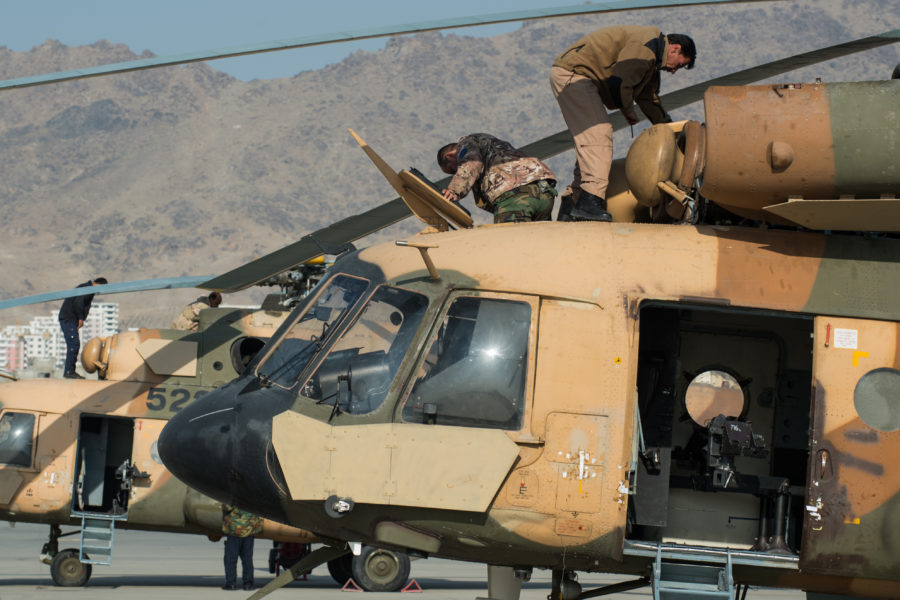The U.S. created an Afghan air force that was too technologically advanced for its native country to sustain, then pulled the rug out from under it, according to a U.S. government inspector general report.
A blistering 148-page document by the Special Inspector General for Afghanistan Reconstruction (SIGAR) found that Afghan security forces were too heavily reliant on U.S. forces for airstrikes and on American maintenance contractors to keep Afghan aircraft flying. When the Biden administration abruptly withdrew its forces in 2021, following the agreement the Trump administration made with the Taliban in 2020, Afghan National Security Forces (ANDSF) were unable to sustain themselves.
The SIGAR report found decisions the U.S. made regarding Afghanistan’s air force particularly confounding.
The U.S. didn’t expect the Afghan Air Force (AAF) to be self-sufficient when the U.S. withdrew. Aghan forces were heavily reliant on aircraft to move about the country because of Afghanistan’s mountainous terrain and the Taliban’s large areas of control.
“Afghans were familiar with the Soviet-made Mi-17 helicopter that was a core AAF component at the start of the U.S. engagement in Afghanistan, and they were able to do most of the maintenance on those aircraft,” SIGAR said.
Afghanistan might have been able to sustain its Soviet aircraft with its own maintainers by 2019, SIGAR said, if only the U.S. military had not begun transitioning the AAF to U.S.-made platforms.
“The shift from Mi-17s to UH-60s moved the date for AAF self-sufficiency back to at least 2030,” the SIGAR report said. Leaving in 2021 put the AAF in an untenable bind.
In 2020, a year before the U.S. withdrawal, Afghan maintainers could only conduct around 40 percent of the work themselves, according to SIGAR. Then, in March 2021, the Biden administration decided to pull civilian contract aircraft maintainers out of Afghanistan.
“Resolute Support commander Gen. [Austin S.] Miller warned that the U.S. withdrawal could leave the ANDSF without vital air support and maintenance,” the SIGAR report said. “That is exactly what happened.”
As some aircraft went down for maintenance, other aircraft were flown harder and farther between maintenance intervals, accelerating the problem. The AAF had enough trained pilots but too few skilled maintainers.
“In a matter of months, 60 percent of the Black Hawks were grounded, with no Afghan or U.S. government plan to bring them back to life,” Sami Sadat, a former Afghan general now in exile, told SIGAR.
That left the rest of the Afghan forces in increasingly dire straits. “Afghan soldiers in isolated bases were running out of ammunition or dying for lack of medical evacuation capabilities,” SIGAR said. “Without air mobility, ANDSF bases remained isolated and vulnerable to being cut off and overrun.”
By August 2021, the entire Afghan government collapsed, leading to the chaotic withdrawal and evacuation by the U.S. Air Force of tens of thousands of military and civilians from Kabul.
Pentagon Press Secretary Air Force Brig. Gen. Patrick S. Ryder declined to comment on specific aspects of the SIGAR report but said DOD had provided its input.
Asked if the Department of Defense planned to publicly explain what went wrong, Ryder said DOD had conducted its own classified “lessons learned report,” but could not say if portions of that document will ever be released to the public.
SIGAR reported that “the United States employed a ‘mirror imaging’ approach with the ANDSF—the practice of teaching other countries to fight the U.S. way, with ground troops protected by massive air support.” But when the U.S. prepared to go, the Afghans couldn’t sustain their fight on their own.
The report concluded with a quote from a South Vietnamese Army officer reflecting on the collapse of South Vietnam nearly 50 years earlier: “They taught us to fight like rich men, even though we were living as poor men.”
“In the end, the officer said that he cannibalized several helicopters for spare parts, commandeered one that was still airworthy, and took as many men as he could with him to sanctuary in a nearby country,” the report said. “It was a decision mirrored by Afghan pilots 46 years later in the summer of 2021.”
